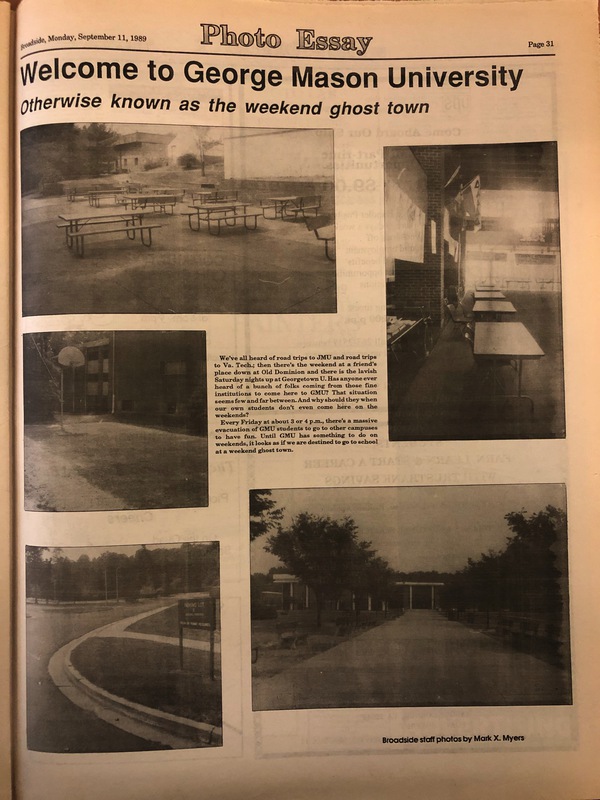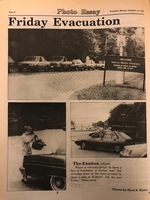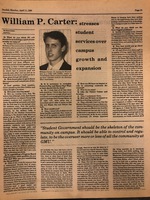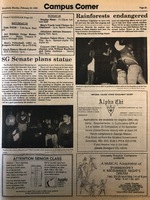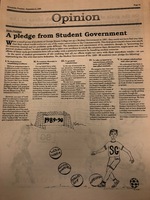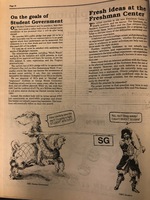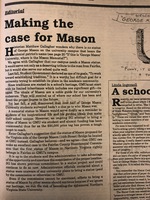"Our campus still has no soul": Creating Campus Traditions
"By a soul, I mean the following: a location on campus that symbolizes the university mission and encapsules the spirit of the school."
- Russel Becker, Broadside
One could easily assume that the statue was a result of the administration interest as, from a logical standpoint, a university would be interested in depicting its namesake. However, the George Mason statue was actually the product of student initiatives throughout the late 1980s. The project was later adopted by the Student Government as an opportunity to create a sense of campus community through a shared identity and traditions. The purpose of this section is to provide further background as to the issues concerning student life, the intervention of Student Government, and how it culminated into a statue project.
It’s Friday, the clock just struck 5p.m., and students are leaving their last class to go pack their belongings in preparation for their weekly weekend trips to other universities. Unfortunately for those living on campus, specifically for those without cars, the university would remain closed until Monday returned. Consequently, George Mason University gained the reputation as the “Weekend Ghost Town” as multiple common areas were completely empty of students until the return of classes.
During the late 1980s, the lacking campus life became a central point with new initiatives to foster student engagement such as Patriot Ball, Patriot Day, and Mason Day; although successful, these programs did not sustain the sense of community that George Mason desperately needed once the parties were over. The student body continued to grow exponentially throughout the 80s; however, student services remained stagnant and student restlessness continued to grow as the university continued to prioritize expansion. [1][2] Russel Becker, an editor of the Broadside newspaper, expressed “our campus certainly cannot be great, the ties that bind us to GMU are weaker, and our university will not be complete without a soul.”[3][4]
William (Bill) Carter sought to remedy these issues by running for Student Government (SG) President in 1988; Carter believed the creation of a special committee dedicated to the advancement of student life would provide the best results improving the quality of life for students—and the reputation of GMU—through improvements in housing, social events, and the relationship with the Fairfax County community.[5][6]
After Carter’s election as a SG President, George Johnson, President of George Mason University, created a task force to function in tandem with the initiatives of the SG to “… figure out why people go away on the weekends… and what kinds of things will make students feel more of a sense of community."[7]
During Carter’s presidency, the SG consistently encouraged tradition-driven initiatives such as Witch Watch; [8]during Carter’s final remaining months as President a notification was published calling for donations for the erection of a George Mason statue. The intention for the statue was to serve as an opportunity for the Mason community to “give back to the university.” SG recognized the limited means of students and student led organizations; therefore, rolling donations were set up for a five-year period in the hopes of raising between $30,000-$50,000 dollars. [9]
The many articles detailing Bill Carter’s accomplishments during his tenure as President exemplified his popularity as a successful President.[10]The next incoming president-elect, Rick Phillips, decided to continue Carter’s focus on improving the campus social life and pledging “to work toward establishing tradition” as SG’s first priority.[11][12][13] Unfortunately this platform did not go without its criticism as one columnist wrote, “we consider SG’s public pledge […] to be a highly honorable way for our representatives to set goals against which their performance can be measured” with further claims that traditions evolve over time and cannot be implemented. [14] Moreover, the issue of student engagement remained a heavy issue throughout the presidencies of Rick Phillips and later President Archie Kao—this suggests that the progress of student government to inspire new traditions was slower than anticipated. Unfortunately, the George Mason statue initiative did not succeed and the documentation concerning the involvement of Student Government is minimal between the years of 1989-1991; this gap in information is most likely as a result of the many turbulent controversies involving the Student Government. [15]
Although news concerning the Mason statue remained silent during the 1989-1991 gap— throughout Northern Virginia the news of an upcoming George Mason memorial was spreading quickly. One historian, Matthew Gallagher, initiated a call to action for George Mason students to persuade the Fairfax Bicentennial Commission of the U.S. Constitution to host the memorial on campus rather than Washington D.C. Two of his main concerns about the current status of the university was that students weren’t familiar with background and accomplishments of their namesake; [16] [17] therefore, there was potential for George Mason University to eventually transform into a generic “Northern Virginia University.” Beyond practicality, as Gallagher argues, the monument of George Mason is a symbol of heritage and as a such, the first statue of George Mason in Northern Virginia should be placed in Fairfax county, his hometown.[18] [19]
[1] These photo essays and an article from the New York Times drew heavy amounts of criticism from students dismissed the lacking student life as inaccurate and purposeful misrepresentative [Link] [Link].
[2] There was tension between the student body and the administration concerning the university's spending. The primary issue concerned the university building a new pond at the new Center for the Arts with $300,000 intended for parking funds. Later the author mocks the university by expressing the next expense should be the Eiffel Tower.
02 February 1990, Broadside, Box 24, George Mason University List of University and Student Publications, Special Collections Research Center, George Mason University, Fairfax, Virginia.
[3] "Media attention could help student life," 08 May 1989, Broadside, Box 23, George Mason University List of University and Student Publications, Special Collections Research Center, George Mason University, Fairfax, Virginia.
[4] "Our campus still has no soul," 01 October 1990, Broadside, Box 25, George Mason University List of University and Student Publications, Special Collections Research Center, George Mason University, Fairfax, Virginia.
[5] "William P. Carter: stresses student services over campus growth and expansion," 04 April 1988, Broadside, Box 22, George Mason University List of University and Student Publications, Special Collections Research Center, George Mason University, Fairfax, Virginia.
[6] "What student life?," 28 November 1988, Broadside, Box 23, George Mason University List of University and Student Publications, Special Collections Research Center, George Mason University, Fairfax, Virginia.
[7] "Task force considers improving student life," 28 November 1988, Broadside, Box 23, George Mason University List of University and Student Publications, Special Collections Research Center, George Mason University, Fairfax, Virginia.
[8] Witch Watch was an event that encouraged college students to patrol neighborhoods during Halloween so that younger children were not at risk of being threatened by teenagers. The event was a success and parents throughout the community contacted the university to request that students continue this program the following year.
07 November, 1988, Broadside, Box 23, George Mason University List of University and Student Publications, Special Collections Research Center, George Mason University, Fairfax, Virginia
[09] "SG Senate plans statue," 20 February 1989, Broadside, Box 23, George Mason University List of University and Student Publications, Special Collections Research Center, George Mason University, Fairfax, Virginia.
[10] "From small town to big city," 17 April 1989, Broadside, Box 23, George Mason University List of University and Student Publications, Special Collections Research Center, George Mason University, Fairfax, Virginia.
[11] "A pledge from Student Government," 05 September 1989, Broadside, Box 23, George Mason University List of University and Student Publications, Special Collections Research Center, George Mason University, Fairfax, Virginia.
[12] "Pres. focuses on social aspect," 17 April 1989, Broadside, Box 23, George Mason University List of University and Student Publications, Special Collections Research Center, George Mason University, Fairfax, Virginia.
[13] "No room for laziness in SG," 10 April 1989, 17 April 1989, Broadside, Box 23, George Mason University List of University and Student Publications, Special Collections Research Center, George Mason University, Fairfax, Virginia.
[14] "On the goals of student government," 05 September 1989, Broadside, Box 23, George Mason University List of University and Student Publications, Special Collections Research Center, George Mason University, Fairfax, Virginia
[15] Rick Phillips was alleged to have violated poster policy violations, illegal canvassing, early campaigning, and name-calling. The following year, newly elected Archie Kao promised an agenda that was similar to his two predecessors; however, he faced a lot of criticism for “failure to follow constitutional procedure” with further concerns that Student Government was a “dictatorship.” In addition, sources claimed Kao slept through a speech delivered by Jesse Jackson and articles reported Kao's attempts to veto Student Senate's resolution condemning offensive activity after Kao's fraternity openly engaged in Black Face.
[16] "Who was George Mason?" 23 October 1989, Broadside, Box 24. George Mason University List of University and Student Publications, Special Collections Research Center, George Mason University, Fairfax, Virginia.
[17] "Making the case for Mason," 23 April 1990, Broadside, Box 24, George Mason University List of University and Student Publications, Special Collections Research Center, George Mason University, Fairfax, Virginia.
[18] "If this is 'George Mason' University, where is the memorial?" 23 April 1990, Broadside, Box 24. George Mason University List of University and Student Publications, Special Collections Research Center, George Mason University, Fairfax, Virginia.
[19] Gallagher’s call to action for the opportunity to obtain more than just traditions did not garner a lot of traction with the student body and the university as suggested by Russel Becker’s article.
